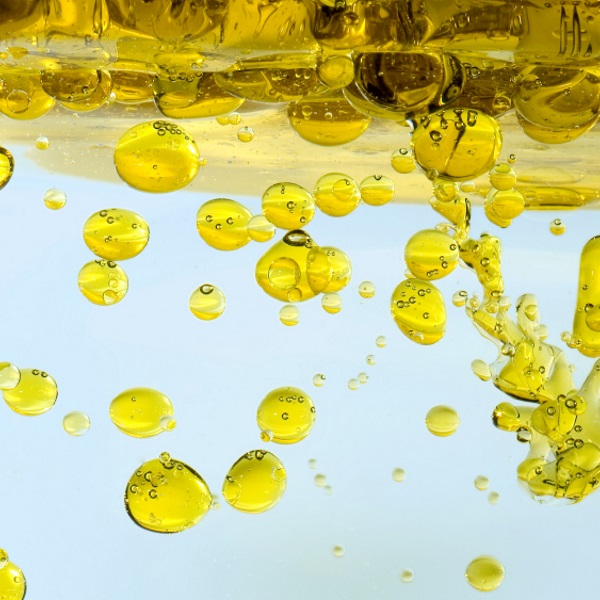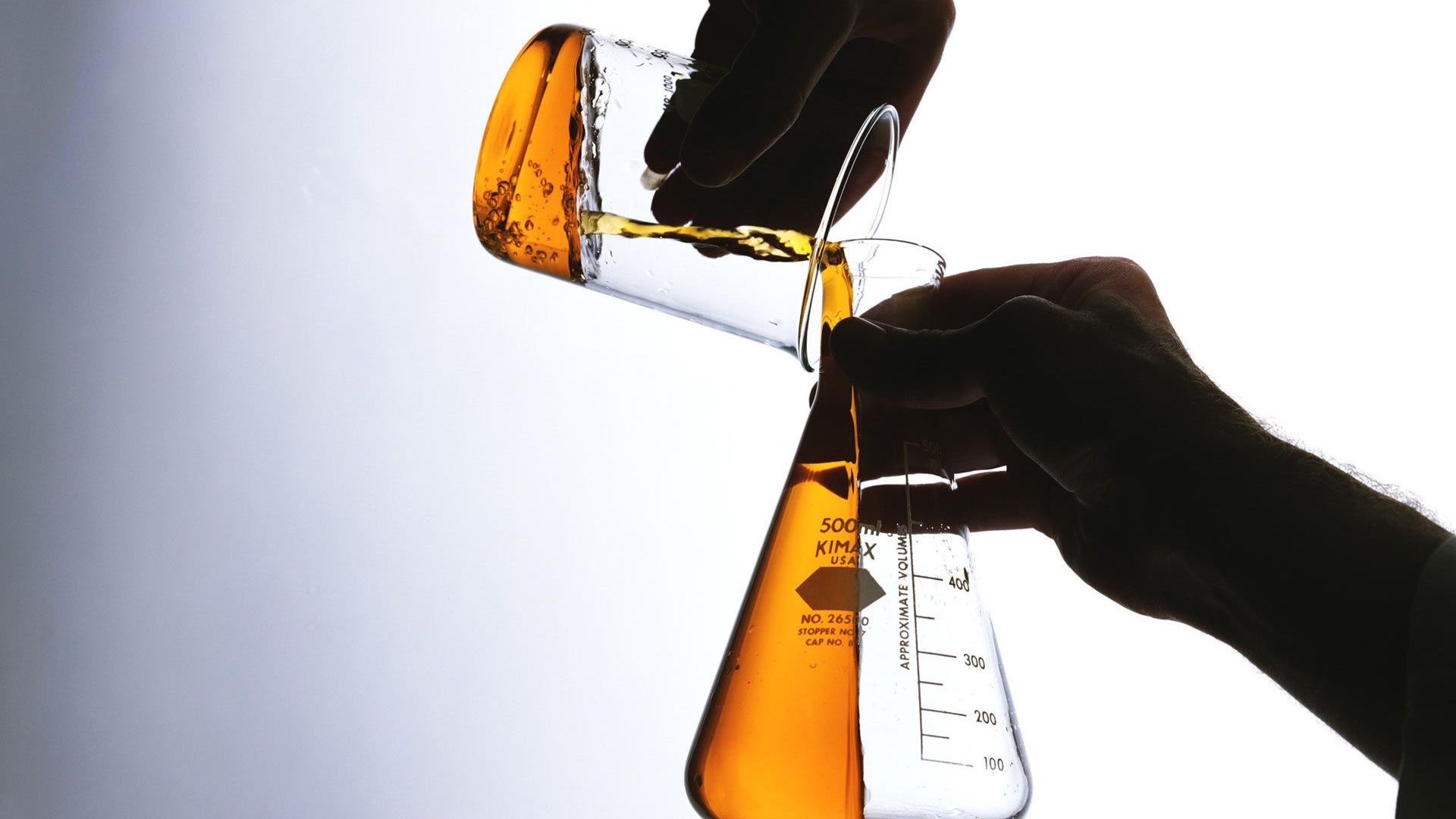Blu Oil
BLU OIL ist ein kationischer Polymer-Demulgator, der für die Spaltung natürlicher oder synthetischer so genannter „dünner“ Emulsionen entwickelt wurde. Von „dünnen“ Emulsionen spricht man, wenn der Anteil an Wasser höher ist als der Anteil an Öl. Diese kommen in verschiederen Bereichen der Industrie vor wie z. B. in der mechanischen Industrie, der Stahlindustrie, im Bergbau, in der rohölverarbeitenden Industrie, der Lebensmittelindustrie und der Fabrikation. etc.
Durch BLU OIL wird eine bessere physische Spaltung der Emulsion bei der Flotation und in der Zentrifuge erreicht.
BLU OIL ist ein flüssiges,leicht anzuwendendes Produkt. Es ist völlig ungefährlich und nicht Gegenstand der ADR-Bestimmungen.
BLU OIL kann in neutraler oder alkalischer Umgebung angewendet werden. Dabei können die Emulsionen:
- entweder statisch im Batch-Prozess,
- oder dynamisch in einem kontinuierlichen Verfahren behandelt werden.
In einem einfachen Prüfstandversuch wird die benötigte Menge ermittelt. Nach dem Mischen mit BLU OIL (auch vorverdünnt) findet die klare Spaltung der öligen und wässrigen Phase statt.
Achtung: Überdosierung kann zu einer Reemulgierung führen.
Die Produktpalette der Demulgatoren für dünne Emulsionen wird durch die Produkte BLU OIL 2C 1, BLU OIL R 1 und R 1F komplettiert. Bei diesen handelt es sich um kationischen Polymere auf Mischbasis, die alternativ zu BLU OIL verwendet werden können, um das beste Ergebnis bei unterschiedlicher Zusammensetzung der zu behandelnden Emulsionen zu erzielen.

Blu Oil
Cationic polymer, de-emulsifier, used to separate into two distinct phases of oil and water from oil emulsions (natural or synthetic) so-called “lean”, in which the water is at a higher percentage than the oil and from many different industries: mechanical, steel, mining and refining of oil, food, manufacturing, etc.
Its use allows to improve the physical breakdown of the emulsions in flotation processes, or centrifugation.
It’s a liquid product easy to use with very low doses, is not dangerous and is not subject to ADR.
The BLU OIL can be used in neutral or alkaline environment:
- in a batch of emulsions,
- in the continuous treatment of emulsions.
Simple bench test will determine the amount needed: after mixing with the Blue Oil (also pre-diluted) you get to the clear separation of two phases, aqueous and oily.
Warning: overdose can lead to re-emulsifying.
The range of de-emulsifiers for emulsions “lean” is completed by the BLUE OIL 2C 1, BLUE OIL R 1 and R 1F. These cationic polymers mixed base to be used alternatively to the BLU OIL to achieve the best performance according to the different composition of the emulsions to be treated.

Blu Oil
Polimero cationico, disemulsionante, impiegato per separare in due fasi ben distinte acqua ed olio dalle emulsioni oleose (naturali o sintetiche) cosiddette “magre”, nelle quali l’acqua è in percentuale maggiore rispetto all’olio e provenienti dai più disparati settori industriali: meccanico, siderurgico, di estrazione e raffinazione di idrocarburi, alimentare, manifatturiero, ecc.
Il suo utilizzo permette di migliorare la rottura fisica delle emulsioni anche in processi di flottazione o centrifugazione.
È un prodotto liquido di facile impiego con dosaggi molto contenuti, non è pericoloso e non è soggetto a norme ADR.
Il BLU OIL può essere usato in ambiente neutro o alcalino:
- nel trattamento discontinuo di emulsioni,
- nel trattamento continuo di emulsioni.
Semplici prove a banco determineranno la quantità necessaria: dopo la miscelazione con il BLU OIL (anche pre-diluito) si arriva alla separazione netta delle due fasi, acquosa e oleosa.
Attenzione: il sovradosaggio può dar luogo a riemulsionamento.
La gamma dei disemulsionanti per emulsioni “magre” si completa con il BLU OIL 2C 1, BLU OIL R 1 e BLU OIL R 1F. Si tratta di polimeri cationici a base mista da usare in alternativa al BLU OIL per raggiungere delle performance migliori on base alla diversa composizione delle emulsioni da trattare.

Instructions
Instructions for the treatment of batch emulsion
The de-emulsion with Blu Oil is made in the collection tank of the oily wastewater to encourage the separation of the oily phase from the aqueous phase.
The following steps describe the de-emulsion phases:
- collect the emulsion in the storage container,
- operate the agitator to facilitate the homogenization of the solution to be treated (alternatively with a current of nitrogen or compressed air taking into account the stripping phenomena),
- check the conditions of pH of the mixture,
- add the Blue Oil: from 2 to 5 ppm (liters per cubic meter),
- continue the agitation of the solution,
- stop agitating and decant for a time varying between half an hour and a few hours (the sedimentation time will indeed increase withe the increase of the content of oil and sludge) to encourage the separation of the two phases (oily upper, aqueous bottom),
- possibly facilitate the separation of the phases by the addition of a coagulant (ferric chloride, aluminum chloride) and increase the size of “flakes” dosing of polyelectrolyte,
- the lower aqueous phase, pollutant-free, will then return to the industrial cycle,
- the upper oil phase is collected and delivered to authorized collectors.
WARNING: make sure that before the addition of BLU OIL the wastewater homogeneous has alkaline pH ( >8 ).
Instructions for industrial treatment
Is carried out first in the de-emulsion equalization tank of the following wastewater:
- oily water
- oily emulsions, oil sludge
- remediation water containing oil
- The following describes the de-emulsion steps:
- store 50-60 cubic meters of wastewater,
- stir with a nitrogen stream (alternatively compressed air) the wastewater on the tank, to give uniformity to the material,
- check the conditions of pH of the mixture,
- add the de-emulsifiers: 2 to 5 ppm (liters per cubic meter),
- continue the agitation of the solution,
- stop agitating and decant a few hours (or overnight) to encourage the separation of the two phases (oily upper, lower aqueous),
- the lower aqueous phase is transferred in the storage tanks for subsequent chemical-physical finishing treatment,
- the upper oily phase (supernatant) is transferred into the storage tank for recovery of oil sludge.
WARNING: make sure that before the addition of BLU OIL the wastewater has homogeneous alkaline pH ( >8 ).
Anleitung für die Behandlung von Emulsionen im Batch-Verfahren
Die Deemulgierung mit Blu Oil findet im Sammeltank des öligen Abwassers statt, um die Spaltung der öligen Phase von der Wässrigen Phase zu fördern.
Die nachfolgenden Punkte beschrieben die durchführenden Schritte bei der Deemulgierung:
- die Emulsion in einem Behälter sammeln,
- das Rührwerk so lange betätigen, bis die zu behandelnde Emulsion homogenisiert ist (alternativ einen Stickstoff- oder Druckluftstrom verwenden – jedoch dabei mögliche Nebeneffekte durch Strippen beachten!)
- den pH-Wert der Mischung kontrollieren,
- Blu Oil in einer Dosis von 2-5 ppm (Liter pro Kubikmeter) hinzufügen,
- die Lösung weiterrühren,
- das Rühren einstellen und für einen Zeitraum zwischen einem halben Stunden und mehreren Stunden dekantieren lassen, um die Spaltung der beiden Phase (ölig oben und wässrig unten) zu fördern (die Sedimentationszeit ist umso länger, je höher der Anteil und Öl und Klärschlamm ist),
- eventuell die Spaltung der beiden Phasen durch Beigabe eines zusätzlichen Flockungsmittels (Eisenchlorid, Polyaluminiumchlorid) fördern, um die „Flocken“ je nach Dosierung des Polyelektrolyts zu vergrößern,
- die untere, schadstofffreie, wässrige Phase kann sodann in den Wirtschaftskreislauf rückgeführt werden,
- die obere ölige Phase wird gesammelt und an eine autorisierte Sammelstelle übergeben.
WARNHINWEIS: Stellen Sie sicher, dass das homogenisierte Abwasser vor der Beifügung von BLU OIL einen alkalischen pH-Wert >8 hat.
Anleitung für die industrielle Behandlung
Zuerst wird die Deemulgierung im Ausgleichbehälter beifolgenden Arten von Abwässern durchgeführt:
- ölhaltiges Wasser
- ölige Emulsionen, öliger Klärschlamm
- zu reinigendes Wasser, das Öl enthält
- Die nachfolgenden Punkte beschrieben die durchzuführenden Schritte bei der Deemulgierung:
- einen Tank mit 50-60 Kubikmetern Abwasser füllen,
- das Abwasser im Tank mit einem Stickstoffstrom (alternativ Druckluftstrom) rühren, um das Material zu homogenisieren,
- den pH-Wert der Mischung kontrollieren,
- den Demulgator in einer Dosis von 2-5 ppm (Liter pro Kubikmeter) hinzufügen,
- die Lösung weiterrühren,
- das Rühren einstellen und für einen Zeitraum von einigen (oder über Nacht) dekantieren lassen, um die Spaltung der beiden Phasen (ölig oben und wässrig unten) zu fördern,
- die untere wässrige Phase in einen Speicherbehälter umfüllen und einer chemisch-physikalischen Nachbehandlung unterziehen,
- die obere ölige Phase (Überstand) zur Rückgewinnung des Klärschlammes in einen Speicherbehälter umfüllen.
WARNHINWEIS: Stellen Sie sicher, dass das homogenisierte Abwasser vor der Beifügung von BLU OIL einen alkalischen pH-Wert >8 hat.
Istruzioni per il trattamento in discontinuo delle emulsioni
Nella vasca di raccolta del refluo oleoso si effettua il disemulsionamento con Blu Oil per favorire la separazione della fase oleosa da quella acquosa.
Di seguito sono descritte le modalità di disemulsionamento:
- raccogliere l’emulsione nel recipiente di stoccaggio,
- azionare l’agitatore per favorire l’omogeneizzazione della soluzione da sottoporre a trattamento (in alternativa con una corrente di azoto o aria compressa considerando i fenomeni di strippaggio),
- verificare le condizioni di pH della miscela,
- aggiungere il Blu Oil: da 2 a 5 ppm (litri per mc),
- continuare l’agitazione della soluzione,
- interrompere l’agitazione e lasciare decantare per un tempo variabile tra mezz’ora e alcune ore (il tempo di sedimentazione potrà infatti aumentare con l’aumento del contenuto di olio e morchie) per favorire la separazione delle due fasi (oleosa superiore, acquosa inferiore),
- eventualmente favorire il distacco delle fasi con l’aggiunta di un coagulante (cloruro ferrico, policloruro di alluminio) e aumentare le dimensioni dei “fiocchi” dosando del polielettrolita,
- la fase acquosa inferiore, priva dell’inquinante, potrà quindi ritornare nel ciclo industriale,
- la fase oleosa superiore viene raccolta e consegnata ai raccoglitori autorizzati.
ATTENZIONE: verificare che prima dell’aggiunta del BLU OIL il refluo omogeneo abbia pH alcalino ( >8 ).
Istruzioni per il trattamento industriale
Si effettua dapprima il disemulsionamento nella vasca di equalizzazione dei seguenti reflui:
- acque oleose
- emulsioni oleose, morchie oleose
- acque di bonifica contenenti olio
- Di seguito sono descritte le modalità di disemulsionamento:
- stoccare 50-60 mc di refluo,
- agitare con una corrente di azoto (in alternativa aria compressa) il refluo nel serbatoio, per dare omogeneità al materiale,
- verificare le condizioni di pH della miscela,
- aggiungere il disemulsionante: da 2 a 5 ppm (litri per mc),
- continuare l’agitazione della soluzione,
- interrompere l’agitazione e lasciare decantare alcune ore (o un’intera notte) per favorire la separazione delle due fasi (oleosa superiore, acquosa inferiore),
- la fase acquosa inferiore viene trasferita nei serbatoi di stoccaggio per successivo trattamento di inissaggio chimico-fisico,
- la fase oleosa superiore (surnatante) è trasferita nel serbatoio di stoccaggio di recupero delle morchie oleose.
ATTENZIONE: verificare che prima dell’aggiunta del BLU OIL il refluo omogeneo abbia pH alcalino ( >8 ).
Blu Oil HP R1
Dieser Demulgator wurde speziell zur Behandlung von „dicken“ Emulsionen, in denen der Wasseranteil geringer als der Ölanteil ist, entwickelt.
Solche Emulsionen kommen in folgenden Fällen vor:
- in der öligen Phase beim Spalten von dünnen Emulsionen,
- in Altöl oder Klärschlammtanks, in denen eine kleine Menge an Wasser enthalten ist,
- im Bilgenwasser von Schiffen,
- in Wasser nach der Raffination von Rohöl
HP R1 kann folgendermaßen verwendet werden:
- Statisch (Batch); das Produkt wird vor dem Mischen und dem anschließenden Abschöpfen in die vorgewärmte Emulsion beigemengt.
- Dynamisch (kontinuierlich); das Produkt wird nach dem Aufwärmen beigemengt und vermischt. Die entstandene Mischung wird in einer Drei-Phasen-Zentrifuge in Öl, Wasser und Sediment gespalten.
Vor jedem industriellen Verfahren müssen Prüfstandversuche hinsichtlich folgender Punkte gemacht werden:
- der Homogenisierung der zu behandelnden Emulsion (damit die Proben repräsentativ sind), und
- der steigenden Dosis von HP R1 bis zum gewünschten Resultat.

Blu Oil HP R1
lt’s a de-emulsifier for the treatment of emulsions so-called “fat”, in which the water is in a percentage lower than the oil.
These emulsions can arise
- from the oil phase obtained by the breaking of emulsions lean,
- from waste oil and sludge tanks containing small amounts of water,
- from bilge water of ships,
- from water after refining and processing of crude oil.
The HP R1 can be used
- treatment with static (batch), by adding the product in the preheated emulsion after mixing and subsequent decantation,
- treatment with dynamic (continuous), after the preheating step, addition of the product and mixing: the mixture obtained will pass in a three-way centrifuge from which it will get three distinct phases of oil, water and sediment.
Before each industrial treatment, it is necessary to conduct bench experiment:
- to homogenize emulsions to treat (so that the samples are representative),
- to dose increasing amounts of HP R1 until the necessary result.

Blu Oil HP R1
È un disemulsionante creato per il trattamento di emulsioni cosiddette “grasse”, nelle quali l’acqua è in percentuale inferiore rispetto all’olio.
Queste emulsioni possono derivare
- dalla fase oleosa ottenuta dalla rottura delle emulsioni magre,
- da oli esausti e fondami di serbatoi contenenti piccole quantità di acqua,
- da acque di sentina delle navi,
- da acque di raffinazione e del trattamento del greggio.
L’HP R1 può essere usato:
- sia con trattamento statico (a batch), addizionando il prodotto nella emulsione preriscaldata previa miscelazione e successiva decantazione,
- sia con trattamento dinamico (in continuo), dopo la fase di preriscaldamento, aggiunta del prodotto e miscelazione, la miscela ottenuta passerà in una centrifuga a tre vie dalla quale si otterranno tre fasi ben distinte di olio, acqua e sedimento.
Prima di ogni trattamento industriale è necessario effettuare delle prove a banco nelle quali:
- omogeneizzare le emulsioni da trattare (cosicché i campioni ottenuti siano rappresentativi),
- dosare quantità crescenti di HO R1 fino al risultato necessario.

Contacts
HectorEurope Srl
Via Enrico Mattei, 7
35020 Terradura (PD)
Italy



